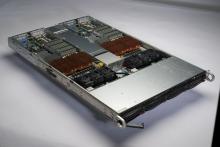
The CERN computer centre has hundreds of racks lke these. They are over a million times more powerful than our first computer in the 1960's.
This tray is a 'dual-core' server. This means it effectively has two CPUs in it (eg. two of your home computers minimsed to fit into a single box). Also note the copper cooling fins, to help dissipate the heat.
There are many advantages of using this type of CPU technology. They take up less space and this means that signals between different CPUs travel shorter distances, and therefore those signals degrade less. These higher-quality signals allow more data to be sent in a given time period, since individual signals can be shorter and do not need to be repeated as often.
Multi-core CPU designs require much less printed circuit board (PCB) space than do multi-chip SMP designs. Also, a dual-core processor uses slightly less power than two coupled single-core processors, principally because of the decreased power required to drive signals external to the chip. Furthermore, the cores share some circuitry.
Multi-core chips also allow higher performance at lower energy. This is a critical factor when running a data centre the size of one like CERN's.
